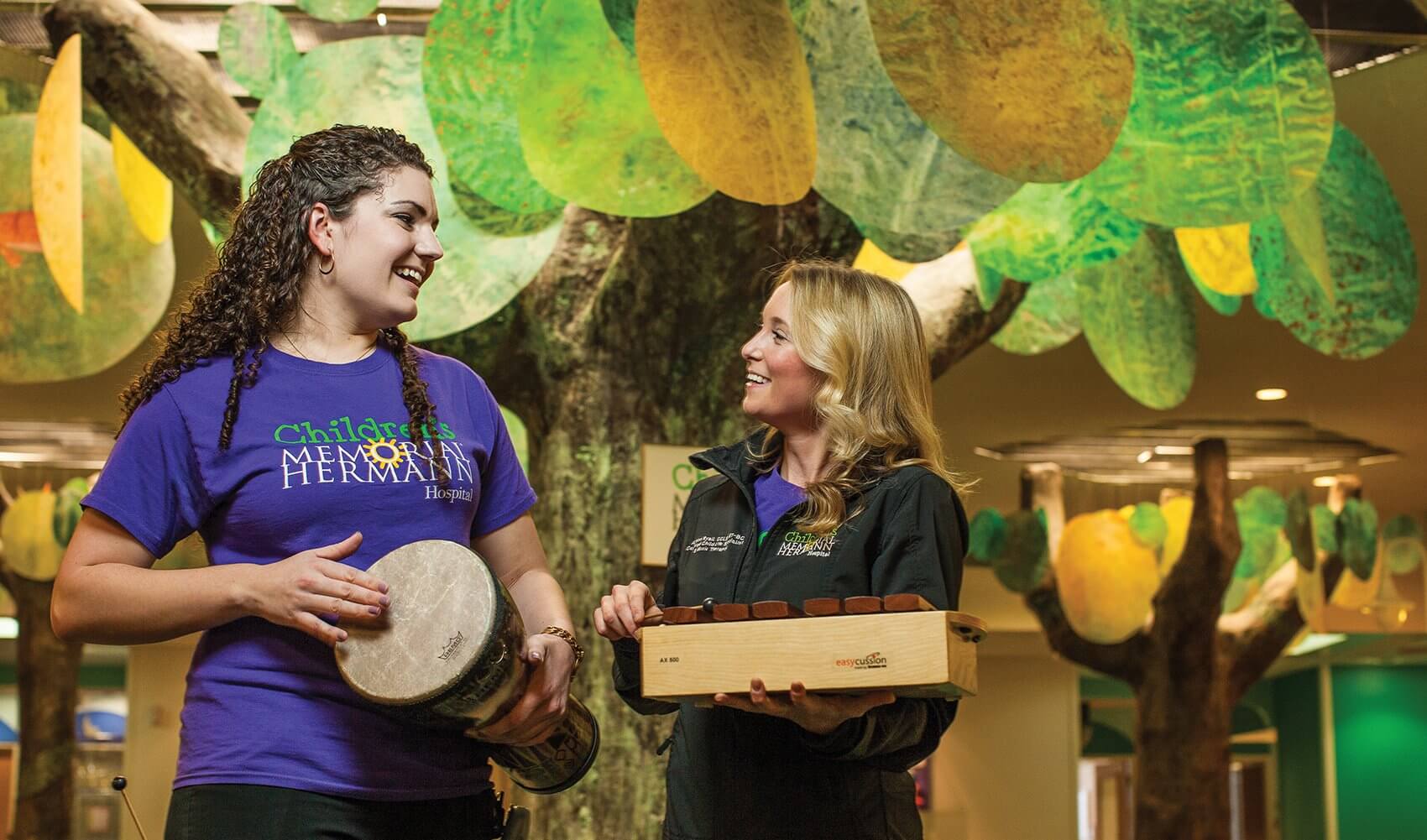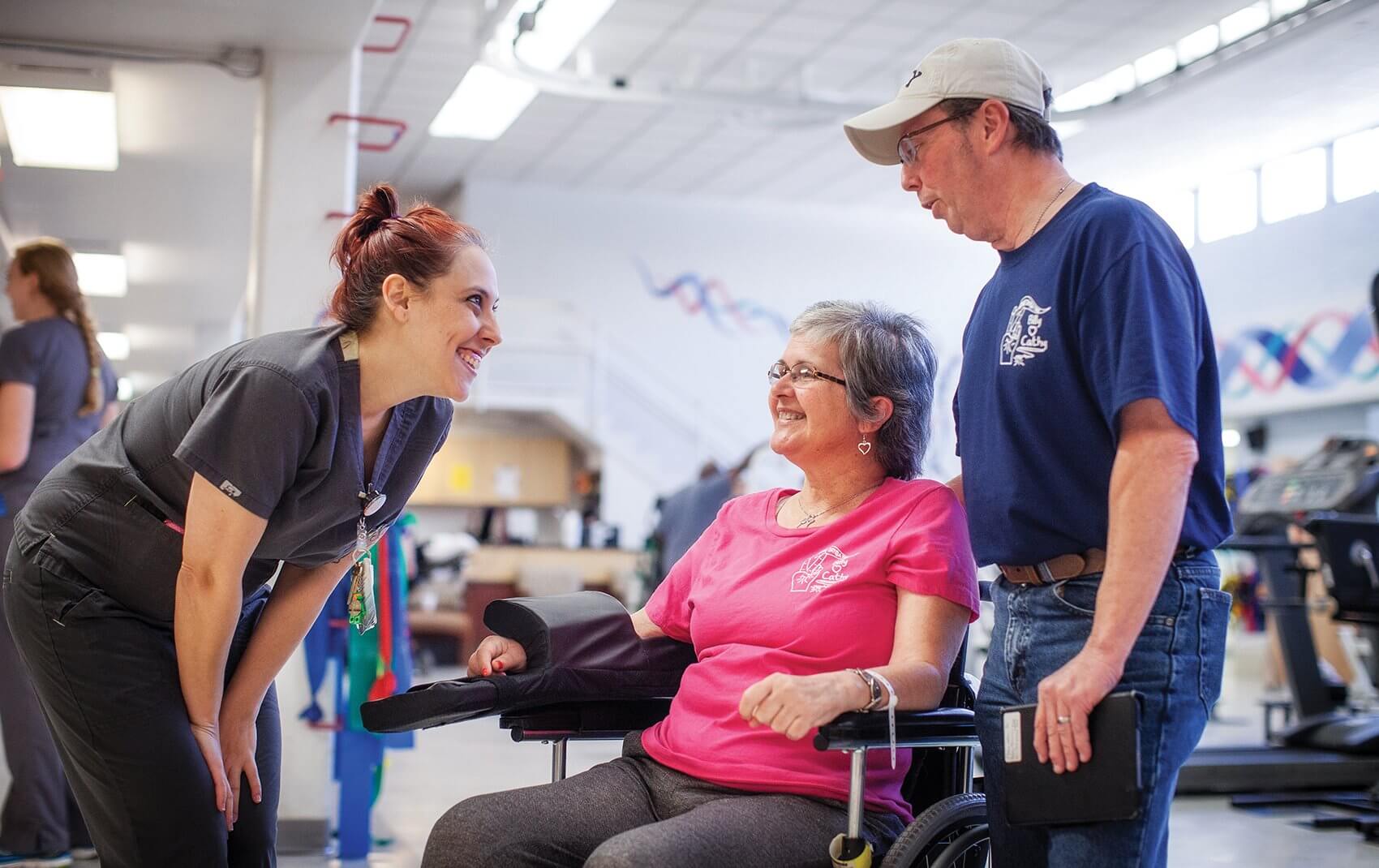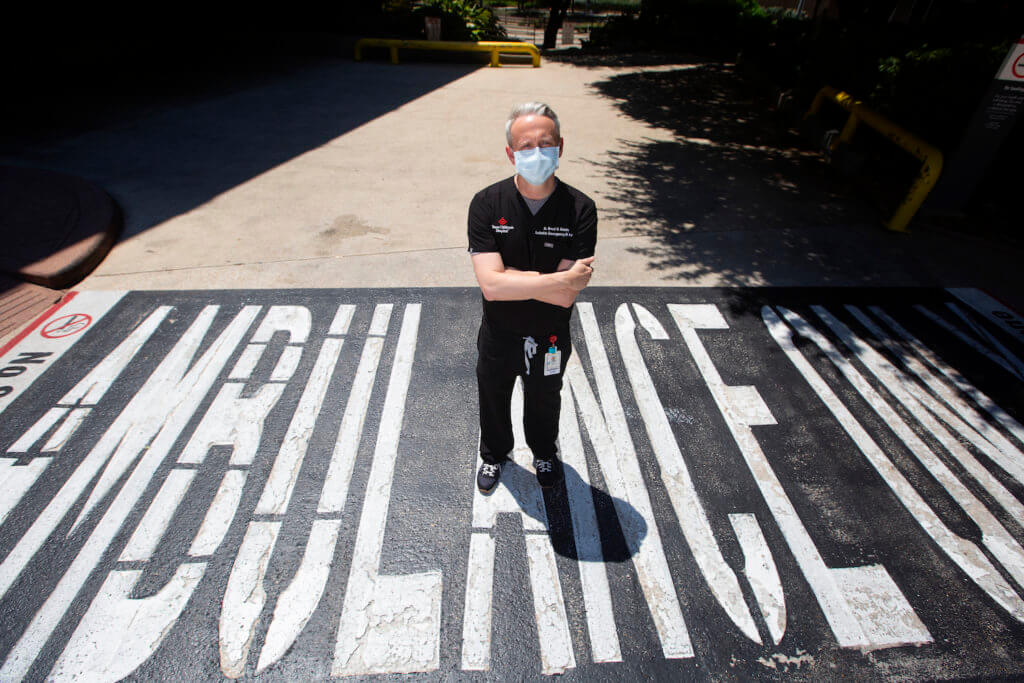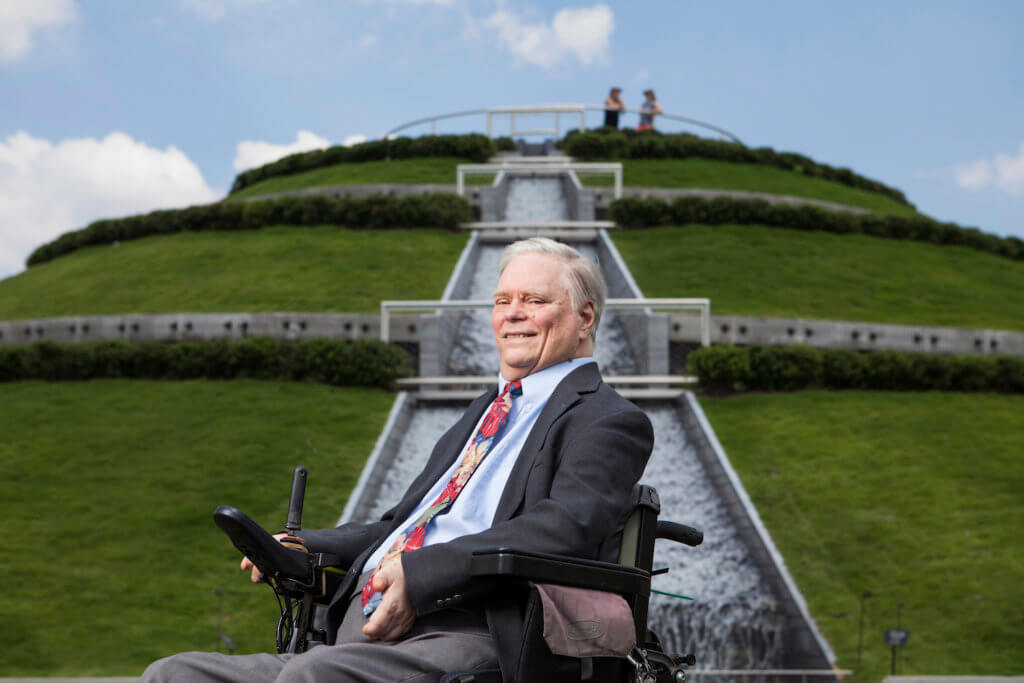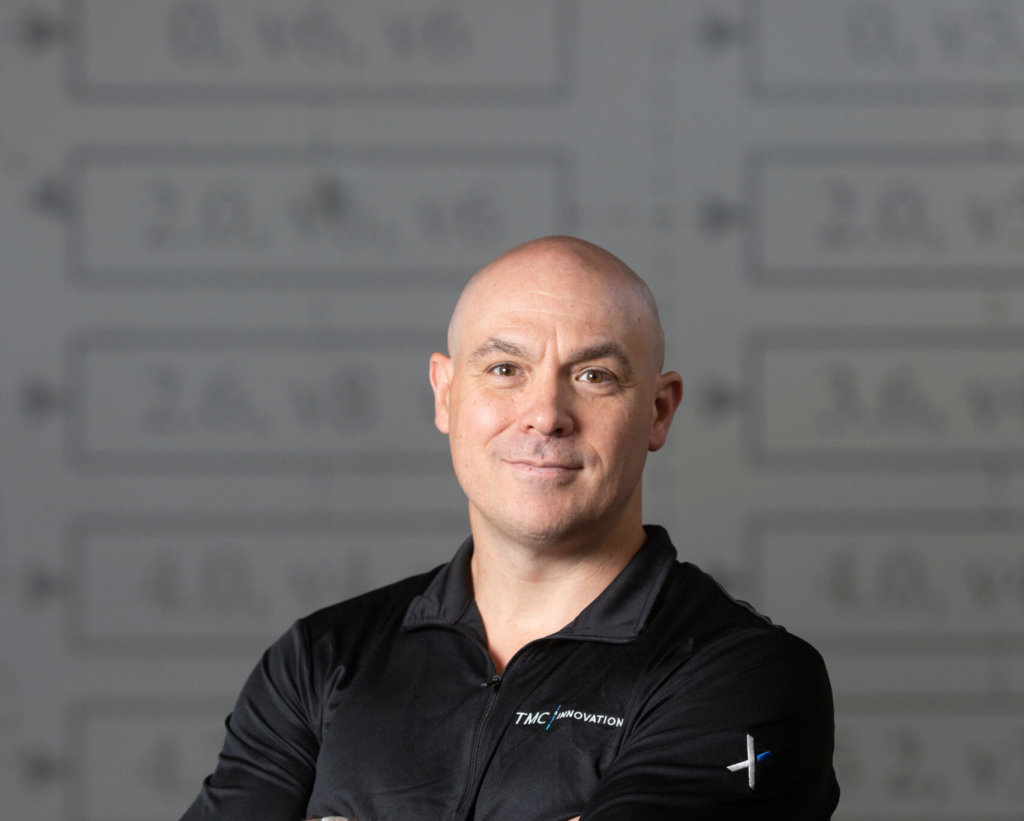A Key to Recovery

Spend ten minutes with Maegan Morrow and you will see how much she truly loves helping people. It’s not just in the way her face lights up when she talks about the work she has done over the past 15 years. It’s also evident when patients stop her in the hallway for a hug, or offer updates on their at-home therapy sessions.
Morrow is part of TIRR Memorial Hermann’s team of music therapists—all trained in utilizing neurologic music therapy techniques to help stimulate speech, increase mobility, and generally improve quality of life for patients struggling to overcome stroke or traumatic brain injury.
It’s a lesser-known form of therapy, but growing in popularity thanks to the dedication of those in the field, and high-profile stories like that of Gabrielle (Gabby) Giffords, a former Arizona congresswoman who suffered severe trauma to the left side of her brain after she was shot at a local community event in 2011. Giffords was transferred to Memorial Hermann-Texas Medical Center, then TIRR Memorial Hermann, in the weeks following the shooting, and worked regularly with a team of speech, occupational, physical and music therapists, including Morrow and her colleague Amy Marroquin.
While Giffords still struggles with aphasia—trouble recalling and stringing together words—she is quick to sing along with some of her favorite songs from the Broadway musical, “Annie.” Monica Verduzco- Gutierrez, M.D., Medical Co-Director of the Outpatient Medical Clinic at TIRR Memorial Hermann, and Assistant Professor at The University of Texas Health Science Center at Houston (UTHealth) Medical School, explained how the brain processes language and music.
“Our brains are all very similar, and the language centers for almost everyone are going to be on the left side of our brain, in certain areas,” she said. “There is an area that makes you come out with the word, there is an area that helps you comprehend the word…and for most people, those are on the left side of the brain.
“Music is not just one side of the brain or the other. Music is everywhere in the brain, because music can be so complicated and you have to be able to understand pitch, intonation, rhythm and the words that are coming through the music. So both sides of the brain process that. And we definitely think that music therapy helps for patients who have aphasia. Particularly for patients who have a musical background, because their brains are more developed towards music. So let’s say someone has aphasia or is a little bit paralyzed in an arm, but they previously played the guitar and sang. They have really complex neurons laid down in their brain, and I think they would be more likely to get the movement and words back because of how complex their brain is from being a musician before and their ability to pull language from different areas of the brain through music.”
Before a massive stroke last year robbed her of speech and mobility, Cathy Flowers was always actively involved with her husband Billy’s band— dancing and singing along during their shows and practice sessions. So when Billy was told early on that Cathy’s outlook was so dismal that even if placed in a nursing home she would “only be taking up space,” he had a hard time accepting that he would never again enjoy those moments with his wife. So Billy jumped on the opportunity to have his wife transferred to TIRR Memorial Hermann. When she arrived, Cathy was unable to open her mouth and could not speak. Several weeks into her therapy at TIRR Memorial Hermann, Cathy was working with Morrow and Kelly Betts, a physical therapist, when Billy suggested they play a song by Johnny Cash.
“They played the song, ‘Walk the Line,’ and they gave Cathy a fake microphone,” recalled Billy. “And she sat there with Kelly and Maegan and started mouthing the song. As the song went on, she was even singing along with the key chorus. And at the very end, Maegan cut the music off, but Cathy kept on going to sing ‘because you’re mine, I walk the line.’”
That day marked a huge milestone in Cathy’s recovery. It was so monumental that Billy had shirts made featuring a line from the song’s lyrics, “because you’re mine, I walk the line.” For Billy, seeing his wife’s personality and smile return in the seven months since her stroke has been nothing short of incredible. Morrow feels fortunate to be able to help patients reach those milestones.
“In patients like Gabby and Cathy, who were dealing with aphasia, where they can’t get the words out when you ask them a question, spontaneous speech might come out,” she said. “But when I work with them, I use a technique called music/speech stimulation. And it basically looks like I’m just singing with them, but I am actually stimulating speech from their brain. So I am accessing a different part of their brain to retrieve words. I’m retrieving lyrics instead of proper semantic speech.”
Music therapy has also found a home in Children’s Memorial Hermann Hospital, where services range from helping children in their pediatric trauma center work through severe burns or brain injury, to facilitating socialization and parent/infant bonding.
“There is almost never a ‘typical’ day for us here,” said Jessica Jarvis, a music therapist at Children’s Memorial Hermann Hospital. “And I love it because that means I get to use music in a variety of ways for emotional, physical, cognitive, communicative, and/ or social goals. Music is used psycho-emotionally, writing a song to process a death or a traumatic accident. It can be used during the beginning stages of neuro-rehabilitation for patients with brain injuries to increase awareness and purposeful responses, or, in later stages, in the recovery of motor, communicative, or cognitive skills—like the work done by the music therapists at TIRR Memorial Hermann. Music is also used for pain management, whether it’s pain due to the diagnosis, a procedure, or during rehabilitation exercises. The Gate Control Theory of Pain explains how using music, such as playing a drum or singing, creates a type of engagement that lowers the patient’s perception of pain.
“An over-simplified explanation of the gate control theory of pain with music therapy is that when we are going through something painful the brain kind of opens up a pathway to perceive and feel that pain,” she added. “And in the brain music is a ‘large fiber’ stimulation that demands our brain’s attention as well. Because the brain cannot focus on two things at once it essentially ‘shuts the gate’ on the pain pathway and lowers the patient’s perceived pain. And that works for babies all the way up to adults. So with a therapist engaging the patient in music, the patient can engage in their treatment longer, they can stretch farther, and they may potentially need less pain medication.”
“For us, music was like a key that unlocked the doors inside her head that might otherwise have stayed shut or taken longer to open. Music therapy has unlocked her potential.” — Billy Flowers, Husband of TIRR Memorial Hermann patient Cathy Flowers
The three music therapists at Children’s Memorial Hermann Hospital also lead group sessions for infants, school-age children and teens. They work in group activities, through song and instrument play, to provide an outlet for self-expression, develop coping skills, and give young patients some sense of control over their circumstances—control they don’t often feel when it comes to their treatment.
“We have a group, Musical Monday, with school-age patients. The main focus is on social interaction for the kids, through interventions that allow for self-expression and opportunities to be successful,” said Jarvis. “So they’re working on things like turn-taking with each other and following the leader, and getting to assert their own independence with what they want to play and how they want to play it, fast or slow, loud or soft.”
“And those do seem, on the surface, like elementary things,” added Alyson Ryall, a music therapist and child life specialist at Children’s Memorial Hermann Hospital, “but really they go such a long way because these are things that kids don’t get to do in the hospital. Jessica is talking about making choices and asserting their independence and expressing themselves. Whereas in the hospital rooms, to take care of their medical needs, they need to be poked and have different medical tests and things, and they don’t get to be in charge of that. So these groups are really important.”
Memorial Hermann was an early adopter of music therapy, having implemented their program more than 15 years ago to support physical, occupational and speech therapies. However, many patients struggle to find access to music therapists once they leave the hospital, or they face insurers unwilling to cover music therapy sessions.
“Unfortunately, they don’t offer music therapy where we are going [after leaving TIRR],” said Billy Flowers. “It seems like music therapy is not a profitable therapy, and so not a lot of folks offer it. I would never wish this on anyone, to have a personal family member go through what Cathy has been through, but if they could see firsthand, they would understand the magnitude of how good this therapy can be.
“For us, music was like a key that unlocked the doors inside her head that might otherwise have stayed shut or taken longer to open,” he said. “Music therapy has unlocked her potential.”
To help better understand the science behind the techniques—which include musical speech stimulation, melodic intonation therapy, oral motor and respiratory exercises, and rhythmic auditory stimulation, among others—and provide some much-needed visibility and support for the field of music therapy— TIRR Memorial Hermann Chief Medical Officer Gerard Francisco, M.D., is overseeing several research projects. TIRR Memorial Hermann has also partnered with Michael Thaut, Ph.D., director of the Center
for Biomedical Research in Music at Colorado State University, to bring a music therapist training course to Houston. These are all exciting and promising steps forward for the music therapists who see the results every day.
“We do have a large base of research for music therapy, but we are a new field. That’s what I have gone back to school to do,” said Jarvis. “I am getting my Ph.D. in rehabilitation sciences, so I can learn more about how we can produce the kinds of research that will be generalizable and that we can disseminate so that people can start to take music therapy as a standard part of care.
“It’s almost a selfish job, because I love seeing the results with these kids. To see the joy in a mom’s eyes when her child gets up and walks for the first time because it’s easier with music as a stimulation and motivation…I see music therapy making a real difference in my patients. And I just think that’s awesome.”
GATHERING OF FRIENDS
Late last year, the Institute for Spirituality and Health (ISH) partnered with TIRR Memorial Hermann to host their annual “Gathering of Friends” fundraiser. Former TIRR Memorial Hermann patient and Arizona Congresswoman Gabby Giffords attended the event with her husband, Mark Kelly, and was there to cheer on her TIRR Memorial Hermann therapy team as they received the Caring Heart Award.
The event was capped with a performance of the Annie song, “Tomorrow,” by Cantor Daniel Mutlu of Congregation Beth Israel. The song is one of particular importance to Giffords, as her mother would sing it to her often throughout her recovery.
“For almost 60 years now, the mission of the Institute for Spirituality and Health has been ‘to increase awareness of the role spirituality plays in health and healing,” said John Graham, M.D., president and chief executive officer of the ISH. “Our Gathering of Friends Luncheon was
a beautiful reflection of out mission. Our time together gave us the opportunity to reflect on the impact of the devastating injury Congresswoman Gabrielle ‘Gabby’ Giffords sustained and to learn more about the compassionate care she received at TIRR Memorial Hermann was touching. Especially, learning of the role music therapy played in her recovery.
“It was amazing to see Gabby sing the entire song along with the Cantor. That was a spiritual experience for us all. We call them ‘sacred moments’ where we connect with one another in a deep and profound way.”
Also during the ceremony, Kelly offered remarks on Giffords’ journey, and the support that helped carry her through. He thanked her team
of therapists and caregivers from TIRR Memorial Hermann for their role in helping her to never give up.
“While Gabby would certainly trade her own life to bring back any of those six individuals who died that day, she is incredibly thankful for her life, and her friends, family and caregivers,” said Kelly. “Too many to name. People that brought Gabby from that bottom and into the light […] The power of the human spirit is an incredible thing. To watch how hard people fight to survive, and the fight to come back. I got to see that up close.
“Still today when Gabby goes off to do something, like physical therapy, when she gets in the car, the last thing she will say to me is ‘Fight, fight, fight,’” he added. “And I think she learned that from some of you in this room. And she reminds me each day to deny the acceptance of failure.”



